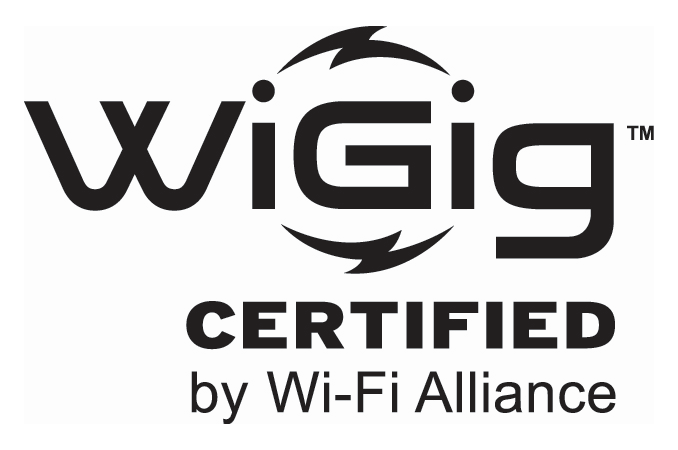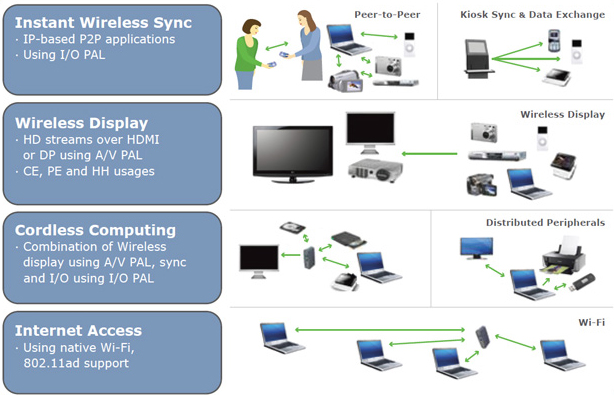Wi-Fi Alliance Begins to Certify 802.11ad WiGig Devices
by Anton Shilov on October 28, 2016 9:00 PM EST- Posted in
- Smartphones
- 802.11ad
- WiGig
- Wi-Fi
- Notebooks
- 60 GHz
- Wi-Fi Alliance

The Wi-Fi Alliance this week began to certify products featuring wireless modules compatible with the 802.11ad standard (aka WiGig). The certification will help to ensure that all WiGig-branded devices, which have been around for some time, can flawlessly operate with each other and deliver expected multi-gigabit performance over 60 GHz spectrum.
The WiGig technology (IEEE 802.11ad) is a short range communication standard that enables compatible devices to communicate at up to 7–8 Gb/s data rates and with minimal latencies, using the 60 GHz spectrum at distances of up to ten meters. Since 60 GHz signals cannot penetrate walls, the technology can be used to connect devices that are in direct line of sight. Given the limitation, WiGig cannot replace Wi-Fi or even Bluetooth, but it can enable devices like wireless docking stations, wireless AR/VR head-mounted displays, wireless high-performance storage devices, wireless displays, and others devices which need a lot of bandwidth.
To date, Intel and Qualcomm have released several tri-band chipsets that support the 2.4 GHz, 5 GHz and 60 GHz spectrums as well as Wi-Fi, Bluetooth and WiGig technologies. The Wi-Fi Alliance has already certified Intel’s Tri-Band Wireless 18260 (Maple Peak) and Qualcomm’s QCA9500 802.11ad-compatible chipsets as well as multiple devices that use them (including Dell’s Latitude E7450/70 as well as 802.11ad 60 GHz USB adapters from Peraso and Socionext). Going forward, the organization will certify other products, including smartphones and docking stations.
It should be noted that the start of WiGig certification on its own isn't going to be the catalyst to cause WiGig adoption to take off, but it will increase chipset developers', device makers', and end users' confidence in the standard. Designers of Wi-Fi chipsets and manufacturers of actual systems have been reluctant to adopt 802.11ad so far because the infrastructure is absent and so is demand, a classic chicken and egg dilemma. With the official certification process things will likely get a little better, mainly because of added confidence.
Meanwhile, analysts from ABI Research believe that 180 million of WiGig-enabled chipsets will ship inside smartphones already next year with 1.5 billion WiGig devices shipping in 2021.
Image Source: Blu Wireless Technology.
Source: Wi-Fi Alliance












50 Comments
View All Comments
eldakka - Sunday, October 30, 2016 - link
As renovich31 said, and you don't need to do the conversion from Gbps to GBps, as a SINGLE PCIe 3.0 (i.e. x1) == 8Gbps.So 802.11ad == 8Gbps == PCIe 3.0 x1 == 8Gbps,
Therefore an x16 is 128Gbps, 16 x faster.
hahmed330 - Monday, October 31, 2016 - link
Terrible analogy since 16 wifis cannot be combined to provide the magnified bandwidth simultaneously to just a single client. It doesn't work that way..Guspaz - Monday, October 31, 2016 - link
They certainly can be, if both peers have 16 wireless radios operation on non-overlapping frequencies. Layer 2 bonding would let you do that if you really wanted to.Wwhat - Sunday, October 30, 2016 - link
60GHz WiFi is only usable in the same room, it can't go through walls really and has a very limited range, it's more like fast Bluetooth than WiFi in that respect.So unless you have that phone in the same room as a router it's not that useful. So how much are people needing it?
Meteor2 - Monday, October 31, 2016 - link
You've never docked a laptop?Meteor2 - Monday, October 31, 2016 - link
To be fair though, it's an interesting point in the tech industry. You could wirelessly dock using WiGig and Rezence or higher-power Qi for charging. But you can also achieve the same with just a single reversible plug (USB-C and its alt modes). I suspect the cable will win, probably just because it's cheaper and simpler (no charging plate installation). But I do love the concept of just placing a device down somewhere and boom, it's docked and charging. With Hello, you just have to look at it to unlock it securely. Awesome.Guspaz - Monday, October 31, 2016 - link
It's not really just about using it for one device though. My desktop has a ton of wires coming out of it, a bunch of which go to devices that already have their own power source that are in the same room. Off the top of my head, I could eliminate wires for my speakers, my projector, my monitor, my printer, and my GigE network.Decluttering wires isn't really the point though, enabling use cases that are impossible now is. Virtual reality currently has to decide between two bad situations: either you have a bunch of wires hanging off your head, or you severely limit the quality of your experience by using onboard mobile-class hardware. Using WiGig to stream the imagery to the headset is the best of both worlds: you get the wire-free approach that makes setting up and using the headset so much better, and you get massively improved battery life because you're not doing any processing on the headset itself.
BoyBawang - Sunday, October 30, 2016 - link
This is the solution to the VR wire problemhahmed330 - Monday, October 31, 2016 - link
Not even close since even 1ms latency would make it quite a jarring experience and bandwidth is still too low..Guspaz - Monday, October 31, 2016 - link
The "presence" threshold (the point below which your brain can't perceive the latency and accepts it as real) is commonly accepted to be 20ms. 1ms isn't going to make or break it alone.The 8Gbps of bandwidth is more than is the raw video bandwidth required for the Oculus Rift (which requires around 5.6 Gbps today), and the nature of VR (high detail in the middle, lower detail away from the centre) lends itself quite well to lossless compression. An optimized pipeline that takes eye tracking into account for transmission and not just foveated rendering could dramatically reduce the bandwidth requirements.